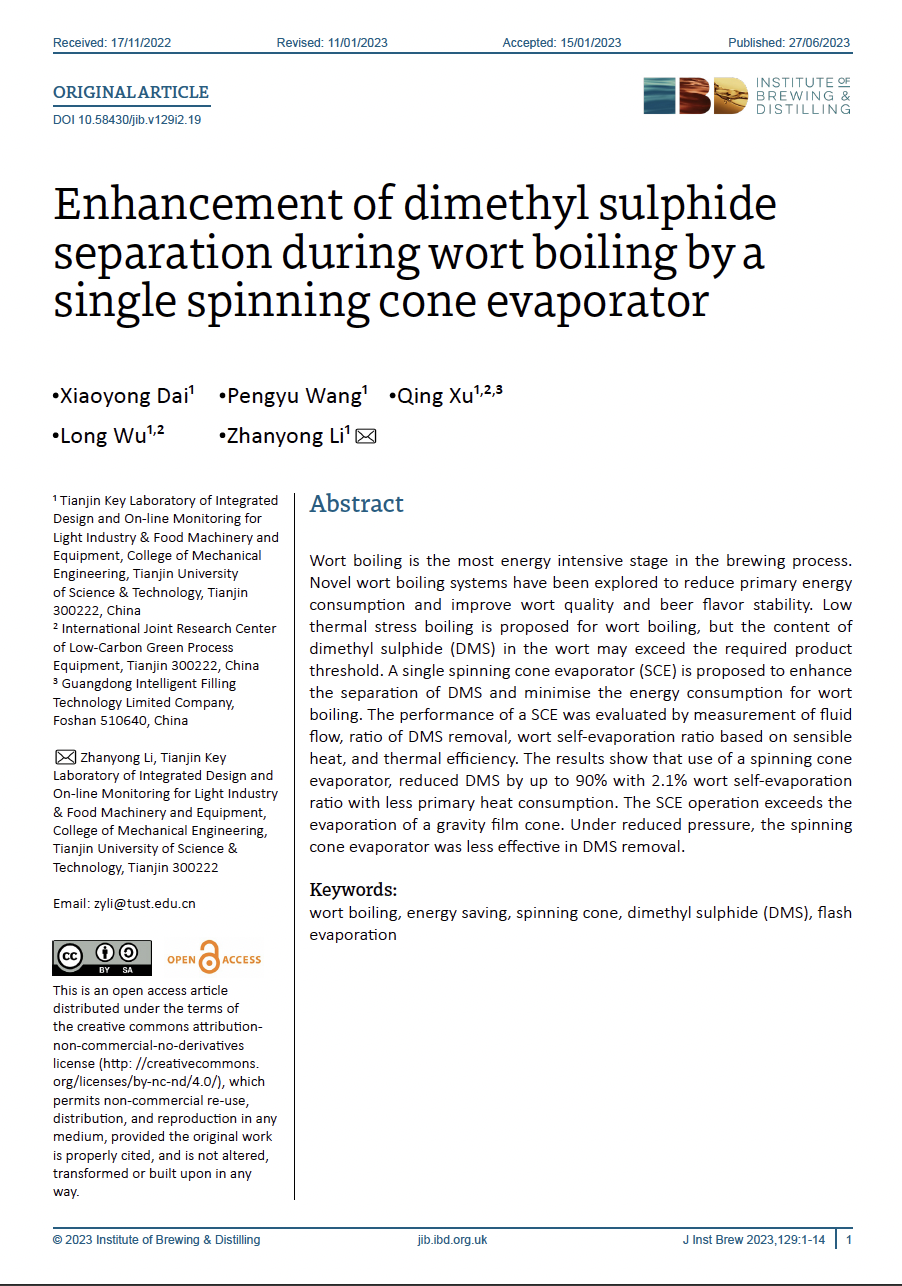Enhancement of dimethyl sulphide separation during wort boiling by a single spinning cone evaporator
DOI:
https://doi.org/10.58430/jib.v129i2.19Keywords:
wort boiling, energy saving, spinning cone, dimethyl sulphide (DMS), flash evaporationAbstract
Wort boiling is the most energy intensive stage in the brewing process. Novel wort boiling systems have been explored to reduce primary energy consumption and improve wort quality and beer flavor stability. Low thermal stress boiling is proposed for wort boiling, but the content of dimethyl sulphide (DMS) in the wort may exceed the required product threshold. A single spinning cone evaporator (SCE) is proposed to enhance the separation of DMS and minimise the energy consumption for wortboiling. The performance of a SCE was evaluated by measurement of fluid flow, ratio of DMS removal, wort self-evaporation ratio based on sensible heat, and thermal efficiency. The results show that use of a spinning cone evaporator, reduced DMS by up to 90% with 2.1% wort self evaporation ratio with less primary heat consumption. The SCE operation exceeds the evaporation of a gravity film cone. Under reduced pressure, the spinning cone evaporator was less effective in DMS removal.
Downloads
References
American Society of Brewing Chemists. 2008. ASBC Analysis Method. Li Q, Liu C.F, (trans). China Light Industry Press, Beijing, 91-95.
Belisario-Sánchez YY, Taboada-Rodríguez A, Marín-Iniesta F, López-Gómez A. 2009. Dealcoholized wines by spinning cone column distillation: phenolic compounds and antioxidant activity measured by the 1, 1-diphenyl-2-picrylhydrazyl method. J Agr Food Chem 57:6770-6778. DOI: https://doi.org/10.1021/jf900387g
Belisario-Sánchez YY, Taboada-Rodríguez A, Marín-Iniesta F, Iguaz-Gainza A, López-Gómez A. 2011. Aroma recovery in wine dealcoholization by SCC distillation. Food Bioproc Tech 5:2529-2539. DOI: https://doi.org/10.1007/s11947-011-0574-y
Bae S, Kim SH, Lee JH. 2020. An investigation into the hydrodynamics of a spinning cone column: CFD simulations by an Eulerian-Lagrangian approach. Comput Chem Eng 132:106635. DOI: https://doi.org/10.1016/j.compchemeng.2019.106635
Catarino M, Mendes A. 2011. Non-alcoholic beer - A new industrial process. Sep Purif Technol 79:342-351. DOI: https://doi.org/10.1016/j.seppur.2011.03.020
Dillenburger M, Zanker G, Werner A, Hertel K, Scheuren H. 2017. Optimization of the vaporization of flavour components during wort boiling in the brewery by implementing a rectification column. J Inst Brew 123:178-184. DOI: https://doi.org/10.1002/jib.419
Feilner R. 2011. Wort stripping: an innovative option for the controlled reduction of unwanted aromatics featuring optimised trickle-film formation and stripping gas utilisation. Tech Quart Master Brew Assoc Americas. 48:51-55. DOI: https://doi.org/10.1094/TQ-48-2-0420-01
Feilner R, Rehmann D, Methner FJ, Baldus M, Kunz T, Scheuren H. 2013a. Wort stripping-Thermodynamic considerations on the evaporation of aroma substances in continuous desorption processes. BrewSci 66:65-74.
Feilner R, Baldus M, Kunz T, Methner FJ. 2013b. Wort stripping: based on thermal desorption, supports the classic boiling process with a more efficient evaporation and without using additional thermal energy. Tech Q Master Brew Assoc Am 50:15-20. DOI: https://doi.org/10.1094/TQ-50-1-0320-01
Feilner R, Werner F, Rehmann D, Methner FJ, Scheuren H. 2015. Q = m c ΔT - basis for the regulation of the mass transfer for processes based on evaporation. Chem Ing Tech 87:583-589. DOI: https://doi.org/10.1002/cite.201400129
Langrish TAG, Makarytchev SV, Fletcher DF, Prince RGH. 2003. Progress in understanding the physical processes inside spinning cone columns. Chem Eng Res Des 81:122-130. DOI: https://doi.org/10.1205/026387603321158276
Miedaner H. 1986. Wort boiling today—old and new aspects. J Inst Brew. 92:330-335. DOI: https://doi.org/10.1002/j.2050-0416.1986.tb04419.x
Makarytchev SV, Langrish T, Fletcher DF. 2002. CFD analysis of spinning cone columns: prediction of unsteady gas flow and pressure drop in a dry column. Chem Eng J 87:301-311. DOI: https://doi.org/10.1016/S1385-8947(01)00245-5
Makarytchev SV, Langrish TAG. 2005. Pressure drop and flooding limit in spinning cone columns. Chem Eng Commun 192:445-473. DOI: https://doi.org/10.1080/0098644059047736
Ogane O, Imai T, Ogawa Y, Ohkochi M. 2006. Influence of wort boiling and wort clarification conditions on aging-relevant carbonyl compounds in beer. Tech Q Master Brew Assoc Am 43:121-126.
Scheuren H, Baldus M, Methner FJ, Dillenburger M. 2016. Evaporation behaviour of DMS in an aqueous solution at infinite dilution - a review. J Inst Brew 122:181-190. DOI: https://doi.org/10.1002/jib.301
Scheuren H, Tippmann J, Methner FJ, Sommer K. 2014a. Decomposition kinetics of dimethyl sulphide. J Inst Brew 120:474-476. DOI: https://doi.org/10.1002/jib.156
Scheuren H, Schuster F, Koukol R, Sommer K, Methner FJ, Dillenburger M. 2016. Determination of a kinetic factor influencing the vaporescence of flavour components from wort. J Inst Brew 122:310-316. DOI: https://doi.org/10.1002/jib.326
Scheuren H, Sommer K, Methner FJ, Dillenburger M. 2015a. Validation of a film evaporator as a wort boiling system. J Am Soc Brew Chem 73: 339-342. DOI: https://doi.org/10.1094/ASBCJ-2015-0922-01
Scheuren H, Feilner R, Sommer K, Dillenburger M. 2015b. Validation and discussion of the vaporization surface. J Inst Brew 121:421-424. . DOI: https://doi.org/10.1002/jib.231
Scheuren H, Methner FJ, Sommer K, Dillenburger M. 2014b. Optimisation of wort boiling by process reformulation and design. BrewSci 67:128-131.
Scheuren H, Methner FJ, Sommer K, Dillenburger M. 2014c. Thermodynamic validation of wort boiling systems. BrewSci 67: 96-100.
Willaert RG, Baron GV. 2004. Applying sustainable technology for saving primary energy in the brewhouse during beer brewing. Clean Technol Environ Policy 7:15-32. DOI: https://doi.org/10.1007/s10098-004-0249-8

Downloads
Published
How to Cite
Issue
Section
License
Copyright (c) 2023 Journal of the Institute of Brewing

This work is licensed under a Creative Commons Attribution-NonCommercial-NoDerivatives 4.0 International License.
This is an open access article which permits non-commercial re-use, distribution, and reproduction in any medium, provided the original work is properly cited, and is not altered, transformed or built upon in any way.
Permission will be required if the proposed reuse is not covered by the terms of the License. In this event, email the Editor in Chief - david.quain@ibd.org.uk - with details of your request.








